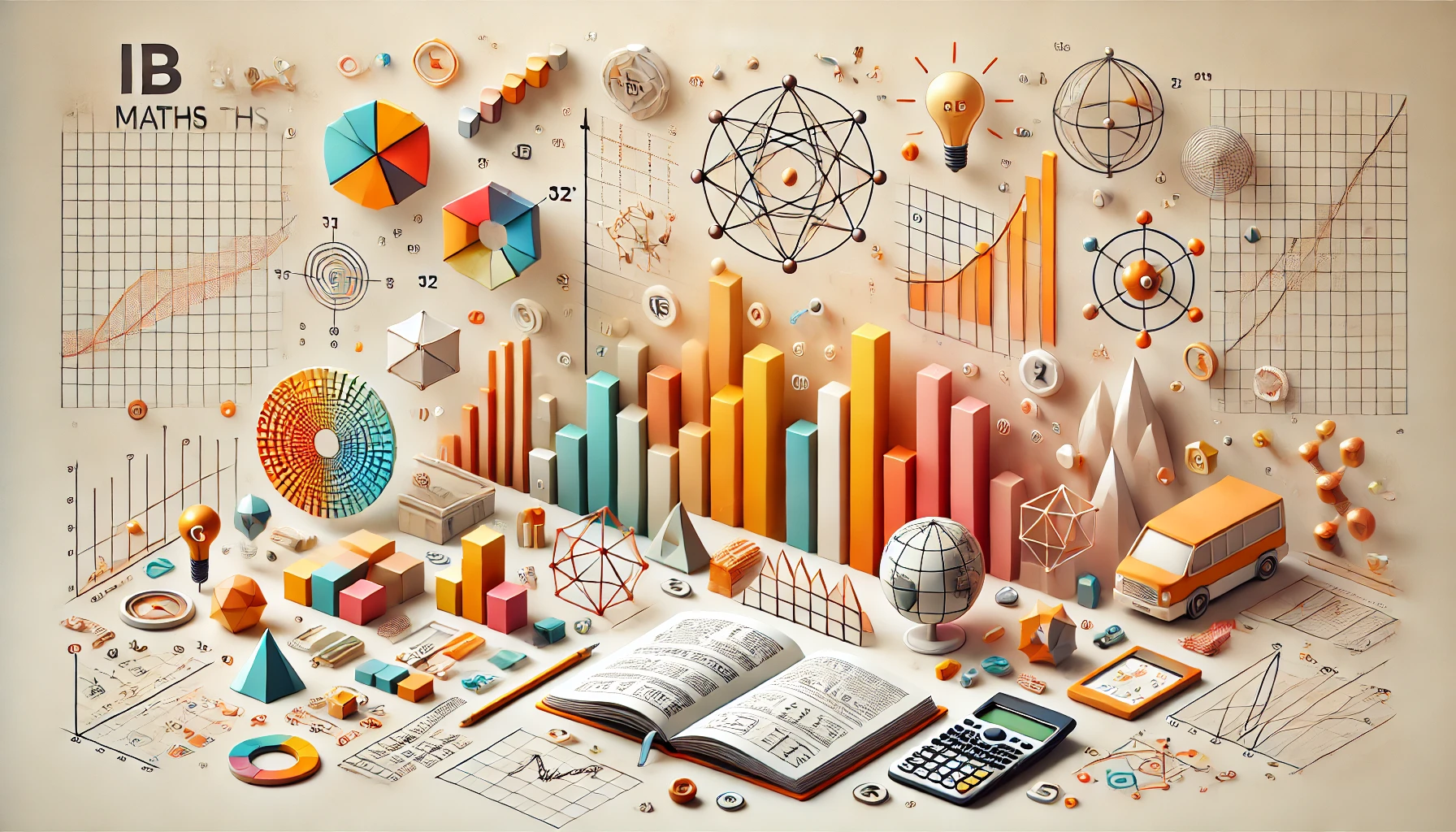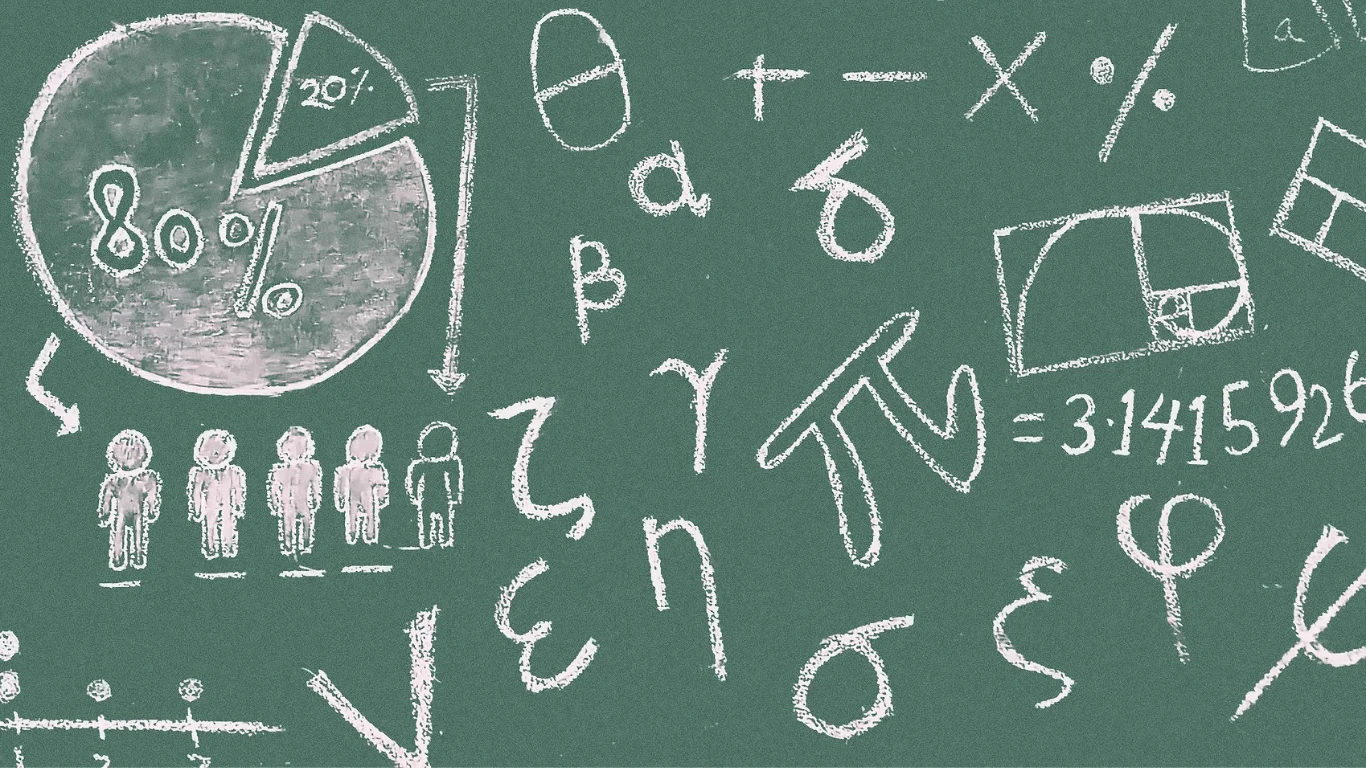
The International Baccalaureate (IB) Diploma Programme is renowned for its rigorous and globally-minded approach to education. One of its standout features is its comprehensive mathematics curriculum, tailored to meet the diverse needs and aspirations of students worldwide.
In this blog, we will delve into IB Mathematics: Applications and Interpretations—a course designed to combine practical problem-solving with the power of mathematical models. Whether you're a student aiming to understand the course, a parent supporting your child, or an educator exploring teaching strategies, this guide covers everything you need to know.
Structure of IB Mathematics: Applications and Interpretation
The IB Mathematics: Applications and Interpretation course is designed to cater to students who enjoy applying mathematics in practical contexts and exploring real-world applications. The course is structured into two levels: Standard Level (SL) and Higher Level (HL), each with distinct requirements regarding teaching hours and depth of content.
Key Components of the Course
Below is a summary of the essential structure and components of the course:
The course prioritises developing skills in critical thinking, problem-solving, and effective communication using mathematical concepts. The time allocation reflects the level of depth and complexity, with HL students engaging in a broader and deeper exploration of the topics compared to SL students.
Overview of IB Mathematics: Applications and Interpretation Topic Organisation
The IB Mathematics: Applications and Interpretation course is structured into five main topics, designed to ensure comprehensive coverage of mathematical concepts and their applications. Each topic builds on students' prior learning and introduces both Standard Level (SL) and Higher Level (HL) content. Additionally, the course incorporates a "Toolkit" and a Mathematical Exploration to emphasise investigative, problem-solving, and modelling skills.
Within each main topic, subtopics are presented in a structured progression to align with the course's conceptual understanding and real-world applications. Some subtopics are more succinct, captured under single dot points, highlighting focused areas of learning.
Topic 1 - Number and Algebra
Number and algebra involve the representation of patterns, equivalencies, and generalisations that are crucial for modelling real-world situations. Algebra extends numerical concepts through the use of variables, enabling the solution of complex mathematical problems.
Topic 2 - Functions
Functions are fundamental in mathematics as they represent relationships between variables, enabling the analysis, modelling, and prediction of real-world phenomena. This topic helps students explore different types of functions and their behaviour, equipping them with tools for data interpretation and problem-solving.
Topic 3 - Geometry and Trigonometry
Geometry and trigonometry enable the exploration of spatial relationships and the properties of shapes and forms. This topic provides tools for solving real-world problems involving measurement, shape, and spatial reasoning, with applications in fields such as physics, engineering, and architecture.
Topic 4 - Statistics and Probability
Statistics and probability enable the interpretation and analysis of data, helping students make informed decisions in uncertain conditions. This topic focuses on summarising data, identifying patterns, and using probability models to predict outcomes, with applications in science, business, and social sciences.
Topic 5 - Calculus
Calculus is a powerful mathematical tool used to study change and motion. This topic equips students with the ability to model dynamic systems, optimise solutions, and understand the behaviour of functions, making it essential in fields such as physics, engineering, economics, and biology.

Skills and Techniques Developed in IB Mathematics: Applications and Interpretation
The IB Mathematics: Applications and Interpretation course equips students with a diverse range of skills and techniques, preparing them to apply mathematical concepts in both theoretical and practical contexts. These competencies are developed through inquiry-based learning, exploration of real-world problems, and the effective use of technology. Below is an overview of the key skills and techniques students will learn throughout the course.
1. Mathematical Modelling
- Students will learn to create, use, and refine mathematical models to describe and solve real-world problems.
- This includes analysing trends, making predictions, and quantifying risk through mathematical tools such as regression analysis and simulations.
2. Analytical Thinking
- Students develop logical reasoning and critical thinking skills to analyse problems and construct mathematical arguments.
- This involves solving abstract problems, understanding proofs, and exploring the relationships between mathematical concepts.
3. Use of Technology
- A core focus of the course is on integrating technology for mathematical exploration and problem-solving.
- Students will use graphing software, spreadsheets, and graphical calculators to model situations, analyse data, and interpret results.
4. Problem-Solving Techniques
- Through topics such as calculus, algebra, and statistics, students learn to approach complex problems methodically.
- Skills include deriving equations, optimising solutions, and calculating probabilities in various scenarios.
5. Communication in Mathematics
- Students will learn to express mathematical ideas clearly and effectively using appropriate terminology, symbols, and notation.
- This includes producing written reports, graphs, and diagrams to convey methods, results, and conclusions.
6. Data Analysis
- A significant emphasis is placed on understanding and interpreting data.
- Students will explore statistical techniques, such as measures of central tendency and dispersion, to draw insights and make informed decisions.
7. Inquiry and Investigation
- The course promotes an inquiry-driven approach, encouraging students to independently explore mathematical concepts and their applications.
- Through the "Mathematical Exploration" component, students investigate an area of interest, apply mathematical techniques, and present findings in a structured format.
8. Adaptability Across Contexts
- The skills learned in this course are transferable to various disciplines, including physics, economics, biology, and environmental studies.
- Students are encouraged to connect mathematical techniques to real-life applications, fostering interdisciplinary understanding.
💡Check out these five key habits and evidence-based strategies of high-achieving students in the IB.

Overview of the IB Mathematics: Applications and Interpretation Internal Assessment (IA)
The Internal Assessment (IA) for IB Mathematics: Applications and Interpretation is a key component of the course, offering students the opportunity to engage in a personal, in-depth exploration of a mathematical topic or concept of their choice. This exploration is not only a practical application of the mathematical knowledge and skills acquired during the course but also an assessment of their ability to investigate, analyse, and communicate effectively.
What is Involved?
- Mathematical Exploration:
- The IA requires students to independently produce a written report that investigates a specific area of mathematics in detail.
- Students select a topic that interests them, often one that connects mathematics to real-world applications or personal interests.
- The exploration should demonstrate the student’s ability to formulate a research question, develop a plan, and conduct an inquiry using appropriate mathematical techniques and tools.
- Length and Structure:
- The final written report typically ranges from 6 to 12 pages.
- It should include a clear introduction, development of ideas with mathematical evidence, critical analysis, and a conclusion.
Key Elements of the Exploration
- Mathematical Content:
- The exploration must include significant mathematical content relevant to the level of the course (SL or HL).
- This may involve algebraic analysis, statistical modelling, calculus, or applications of mathematical tools.
- Personal Engagement:
- Students are encouraged to select topics that showcase personal interest, creativity, and originality.
- The exploration should reflect the student’s individual curiosity and effort to make meaningful connections.
- Use of Technology:
- Students are expected to utilise technology (such as graphical calculators, spreadsheets, or software) to support their analysis and presentation of mathematical concepts.
What is Being Assessed?
The IA is assessed using specific criteria that focus on various aspects of the exploration. These include:
- Criterion A: Presentation
- Clarity and organisation of the report.
- Logical structure and effective communication of ideas.
- Criterion B: Mathematical Communication
- Accurate use of mathematical language, symbols, and notation.
- Presentation of work in a coherent and understandable manner.
- Criterion C: Personal Engagement
- Evidence of student interest, creativity, and independent thought in the exploration.
- Depth of connection between the student’s personal context and the mathematics explored.
- Criterion D: Reflection
- Student’s ability to critically evaluate their methods, results, and the overall process.
- Discussion of the strengths, limitations, and implications of their findings.
- Criterion E: Use of Mathematics
- Level of sophistication, correctness, and relevance of the mathematics used.
- Application of mathematical concepts and techniques appropriate to the course level.
Purpose and Importance
The IA encourages students to:
- Engage in independent learning and critical thinking.
- Apply mathematical knowledge in creative and meaningful ways.
- Reflect on the connections between mathematics and the real world.
- Develop skills in research, problem-solving, and effective communication.
This component represents 20% of the final grade for SL and HL students, making it a vital aspect of the IB Mathematics: Applications and Interpretation course.

Overview of the External Assessment for IB Mathematics: Applications and Interpretation
The External Assessment in IB Mathematics: Applications and Interpretation is a significant part of the course evaluation, comprising written examination papers designed to assess students' understanding, application, and reasoning skills. These assessments vary in format, duration, and complexity for Standard Level (SL) and Higher Level (HL) students.
Assessment Structure
The external assessment includes two papers for SL and three papers for HL. These are outlined below:
Standard Level (SL) External Assessment
Higher Level (HL) External Assessment
What is Being Assessed?
The external assessment evaluates the following Assessment Objectives:
- Knowledge and Understanding: Students demonstrate their understanding of mathematical concepts and techniques.
- Problem-Solving: Students apply mathematical principles to solve problems across various contexts.
- Communication and Interpretation: Clarity in expressing mathematical reasoning through appropriate language, symbols, and diagrams.
- Technology: Effective use of calculators and other tools to model, analyse, and solve mathematical problems.
- Reasoning: Logical deduction, justification of methods, and critical evaluation of results.
- Inquiry Approaches: Exploration of unfamiliar problems, organisation of information, formulation of conjectures, and drawing conclusions.
Importance of Assessment Objectives
- Knowledge and Understanding forms the foundation of the course and ensures students have a strong grasp of core concepts.
- Problem-Solving and Reasoning assess students' ability to apply knowledge in unfamiliar situations, reflecting real-world scenarios.
- Communication and Interpretation encourage students to present solutions coherently, a skill essential for academic and professional success.
- Technology aligns with the course's emphasis on mathematical modelling and applications, equipping students for modern challenges.
- Inquiry Approaches foster independent thinking and adaptability, critical for advanced studies and problem-solving in diverse contexts.
Additional Information
- Formula Booklet: Students have access to a clean copy of the formula booklet during exams.
- Calculator Use: A graphic display calculator (GDC) is required for all papers, but not all questions depend on its use.
- Question Design: Papers contain questions of varying length and difficulty, progressively increasing in complexity within each question.
- Marking Scheme: Marks are awarded for method, accuracy, and reasoning. Partial credit is given for correct approaches even if the final answer is incorrect.
💡Learn how each part of the IB grading system impacts your final diploma score.
Key Differences Between Standard Level (SL) and Higher Level (HL) in IB Mathematics: Applications and Interpretation
The main differences between the Standard Level (SL) and Higher Level (HL) of IB Mathematics: Applications and Interpretation lie in the depth of content, time allocation, and complexity of the mathematical concepts. HL provides a more rigorous exploration of mathematical ideas and places greater emphasis on problem-solving and applications in real-world contexts.
Below is a summary of the distinctions between SL and HL, organised in a table format:
Additional Notes
- Target Audience:
- SL: Designed for students with a general interest in mathematics, who may pursue careers where mathematical applications are secondary.
- HL: Suited for students with strong mathematical skills who aim to pursue mathematics-intensive subjects such as engineering, economics, or natural sciences.
- Expectations of Mathematical Rigor:
- HL involves more abstract thinking, rigorous problem-solving, and integration of multiple mathematical concepts within a single problem.
- Assessment:
- Both SL and HL have their assessments externally moderated to maintain consistency in marking.
- The internal assessment (Mathematical Exploration) encourages students to investigate a topic of interest, but HL demands a higher degree of complexity and sophistication.
💡Check out these effective study techniques that support learning, retention, and academic achievement.
Tips for Success in IB Mathematics: Applications and Interpretation
We have spoken to our tutors and summarised their advice about how to succeed in IB Mathematics: Applications and Interpretation. These tips cover strategies for both general success in the course and excelling in the final exams.
- Understand the Syllabus: Familiarise yourself with the syllabus structure and objectives. Knowing the topics and how they interconnect will help you identify areas to focus on and prioritise your study time effectively.
- Master the Basics: Build a strong foundation in core mathematical concepts like algebra, trigonometry, and functions. Many advanced topics, especially in HL, rely on a solid understanding of these fundamentals.
- Develop Your Problem-Solving Skills: Practice applying mathematical techniques to real-world problems. This is a critical focus of the course, and the more you practise, the more confident you'll become in tackling unfamiliar scenarios.
- Leverage Technology Effectively: Learn to use your graphing calculator (GDC) or software tools efficiently. Explore how technology can help solve equations, visualise functions, and analyse data, as these are integral to both coursework and exams.
- Stay Consistent with Practice: Regular practice is essential. Work on a mix of short-response and extended-response problems from past papers to get comfortable with the exam format and time constraints.
- Engage with the Mathematical Exploration Early: Start your Internal Assessment (IA) early and select a topic that genuinely interests you. Use the opportunity to showcase your personal engagement with mathematics and the depth of your understanding.
- Focus on Conceptual Understanding: Don't just memorise formulas—aim to understand how and why they work. This will help you apply them in different contexts, especially in HL where problems are often more abstract.
- Revise Regularly and Strategically: Schedule time to revisit previous topics while learning new ones. Use a checklist to track your progress and ensure that all areas are adequately covered before the exams.
- Learn to Interpret Questions: Pay close attention to how questions are worded, especially the command terms (e.g., "justify," "explain," "evaluate"). Understanding what the examiner expects will help you structure your responses appropriately.
- Work on Communication Skills: Practice presenting your solutions clearly using proper mathematical notation, diagrams, and logical reasoning. This is key for scoring well on the communication criteria in both the IA and exams.
- Manage Your Time During Exams: Allocate time wisely during the exam. Start with questions you feel confident about to secure easy marks and leave time for reviewing your work.
- Review the Formula Booklet: Familiarise yourself with the formula booklet provided during the exams. Knowing where to find key formulas will save you time and reduce stress.
- Use Real-World Contexts to Learn: Relate mathematical concepts to everyday scenarios or global issues. This not only reinforces learning but also prepares you for questions that involve interpreting data in practical contexts.
- Seek Help When Needed: Don’t hesitate to ask your teacher or tutor for clarification on challenging concepts. Collaborative learning with peers can also help reinforce your understanding.
- Build Confidence with HL or SL-Specific Content: If you’re an HL student, focus on mastering the advanced content, such as calculus and probability. If you’re an SL student, prioritise understanding applications and modelling problems, which are central to the course.
- Reflect on Your Progress: Regularly assess your strengths and weaknesses. This will allow you to adapt your study plan and focus on areas that need improvement.
- Stay Calm and Composed: Stress management is vital. Develop a study routine, take breaks, and stay healthy to ensure you can perform your best in the exams.
💡Practice papers are key for success! Find out why past papers are the ultimate tool for IB Exam preparation.

Common Mistakes IB Mathematics: Applications and Interpretation Students Make
Even the most diligent IB Mathematics: Applications and Interpretation students can make mistakes that impact their performance. Here are some common pitfalls to avoid:
- Over-Reliance on Technology: While calculators and software are essential tools, relying solely on them without understanding the underlying mathematical concepts can lead to errors, especially when interpreting results.
- Neglecting Conceptual Understanding: Memorising formulas without understanding their applications can make it difficult to adapt to unfamiliar questions, particularly in real-world contexts.
- Rushing Through Questions: Failing to read questions carefully or misinterpreting command terms like "justify" or "evaluate" often results in incomplete or incorrect answers.
- Inadequate Practice with Past Papers: Focusing only on textbook exercises and avoiding past papers can leave students unprepared for the format, style, and difficulty of exam questions.
- Weak Mathematical Communication: Neglecting to use proper notation, labels, or clear explanations can cost valuable marks, even when calculations are correct.
- Poor Time Management: Spending too much time on one question and leaving others incomplete is a common mistake, particularly during exams.
- Late Start on the Internal Assessment: Procrastinating on the Mathematical Exploration often leads to rushed work that lacks depth and originality.
- Skipping Error Analysis: Overlooking errors in practice problems or exams prevents students from identifying and correcting recurring mistakes.
FAQs for IB Mathematics: Applications and Interpretation
Here are some common questions students and parents have about IB Mathematics: Applications and Interpretation:
- What is the difference between Standard Level (SL) and Higher Level (HL)?
- SL is designed for students who want a practical understanding of mathematics with applications to real-world problems, while HL is for those who wish to study mathematics in greater depth, often as preparation for maths-intensive university courses. HL covers additional advanced content and requires more teaching hours.
- Is getting a 7 in IB Mathematics: Applications and Interpretation hard?
- Achieving a 7 is challenging but achievable with consistent effort. It requires a strong grasp of the syllabus, excellent problem-solving skills, and a high level of mathematical communication. Regular practice with past papers, thorough preparation for the Internal Assessment, and effective time management during exams are essential.
- How important is the Internal Assessment (IA)?
- The IA contributes 20% to the final grade, making it a crucial component of the course. It allows students to showcase their mathematical exploration and personal engagement, so investing time and effort into producing a thoughtful, well-structured report is key.
- What tools or resources are allowed in the exam?
- Students must bring a graphing display calculator (GDC), which is essential for problem-solving and modelling in the exams. Familiarity with the formula booklet is also important, as it contains key formulas provided during the assessment.
- How can I prepare effectively for the exams?
- Focus on mastering the syllabus content, practising past papers, and understanding the command terms used in questions. Allocate time wisely during the exam, work on both short and extended-response questions, and ensure clear mathematical communication.
- Do universities prefer HL over SL for mathematics?
- It depends on the course and institution. HL is preferred or required for maths-intensive degrees like engineering, physics, or economics, while SL is usually sufficient for other fields where mathematics is less central. Always check university prerequisites for guidance.
Conclusion
IB Mathematics: Applications and Interpretation is a dynamic course that equips students with the tools to apply mathematical concepts to real-world challenges. It encourages practical problem-solving, critical thinking, and the effective use of technology—skills that are invaluable both in academic settings and beyond.
Remember, success in IB Mathematics: Applications and Interpretation isn’t just about mastering the syllabus—it’s about embracing the journey, exploring your interests, and applying mathematics in meaningful ways.
Best of luck on your path to achieving your goals!
